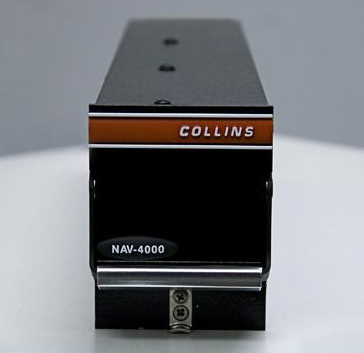 |
| DME-4000 transmitter/receiver. (Photo courtesy Rockwell Collins) |
GENERAL • The DME-4000 has the ability to track three DME stations at once provides accurate updates of aircraft position.
• Station identification recognition provides direct confirmation of information source.
• For enhanced safety, the Collins exclusive echo monitor circuit prevents display of erroneous data from multipath reflected signals.
• ARINC 429 and CSDB tuning and data outputs provide a variety of installation options.
• Single set of high-speed ARINC 429 I/O buses provides tuning, digital audio, navigation data, maintenance data and software data loading capability.
 |
| DME-4000 transmitter/receiver. (Photo courtesy Rockwell Collins) |
OVERVIEW • DME-4000 Distance Measuring Equipment is a member of the Collins Pro Line 21 CNS family of products that feature state-of-the-art digital signal processing technology, digital audio, a consolidated tuning/data/audio bus, comprehensive maintenance software and software data loading.
• Remote-mounted, multichannel DME which operates on 252 channels from 960 to 1215 MHz with both X and Y pulse-pair spacings with a transmitter output power of 300 watts minimum and a minimum receiver sensitivity of -85 dBm.
• Provides information from up to three DME stations utilizing a single receiver/transmitter. The DME-4000 accepts up to three frequency assignments via an ARINC 429 serial digital tuning input from either the RIU or from an auxiliary tuning source. The microprocessor program within the receiver/transmitter (R/T) sequentially directs the unit through a series of tasks for each commanded frequency. The unit performs an interrogation cycle consisting of frequency tune, transmission, reception and processing every 12.5 milliseconds, thus allowing each station to be interrogated up to 26.7 times per second. Individual automatic gain control (AGC level), track status, distance, velocity and identity information for the selected channel are stored at the conclusion of each cycle and restored when that frequency is again sampled.
• Station identifier is automatically processed for display as an adjunct to the audio identity signal to permit direct confirmation of the information source. Display of erroneous data from multipath reflected signals is prevented by continuously searching for returns occurring earlier than the indicated distance. Distance lock occurs within one second of initial tune to a new frequency and identity decode occurs within one minute. Internal diagnostics allow accurate isolation of a failed unit in the aircraft as well as isolation of faults to the functional element in the shop.
The DME is tuned via one of three ARINC 429 ports, one of which is connected to its own side radio tuning unit and one connected to the cross side radio tuning unit. Data for each of the three stations being tracked is output on each of two ARINC 429 ports.CHARACTERISTICS
Channels: 252
Receive Frequency Range: 962-1213 MHz
Transmit Frequency Range: 1025-1150 MHz
Frequency Control: CSDB or ARINC 429 serial data
Power Output: 300 W minimum
Frequency Stability: ± 70 kHz
Sensitivity: - 85 dBm minimumTYPICAL SYSTEM
1 DME-4000 Receiver/Transmitter p/n 822-1466-001
1 ANT-42 Antenna, L-Band.Frequency Rage 960 to 1220 MHz 20 W average
p/n 622-6591-001DIMENSIONS
DME-4000
Height: 87.4 mm (3.34 in)
Width: 63.5 mm (2.50 in)
Length: 358.5 mm (14.12 in)
Weight: 1.54 kg (3.4 lb)
Input Power: 28 VDC
Temperature Range: -55 to 70°C
Altitude: To 70,000 ft
Credits and References:
1) http://www3.rockwellcollins.com/ecat/br/DME-4000.html